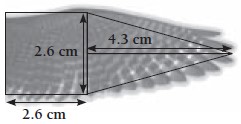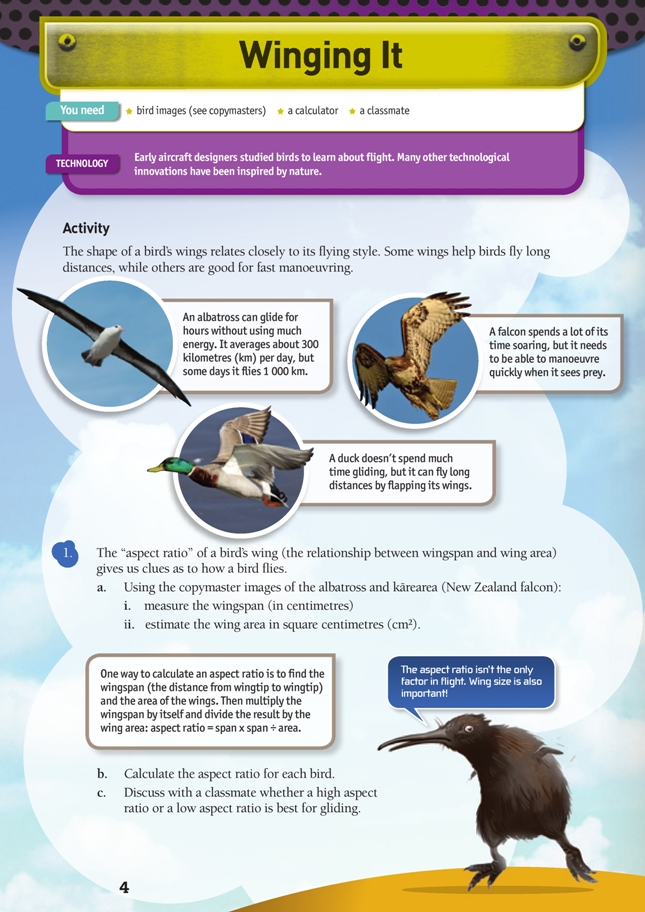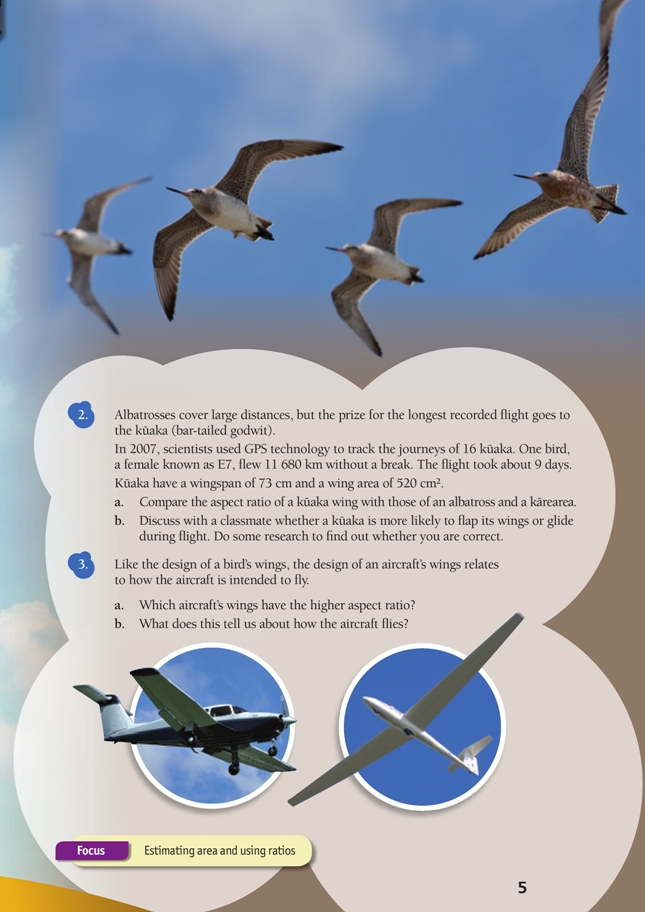This is a level 3 activity from the Figure It Out series.
A PDF of the student activity is included.
Click on the image to enlarge it. Click again to close. Download PDF (944 KB)
Proportion involves comparing one dimension of an object or image with another dimension or comparing the same dimension in two different objects. The emphasis is on the relationship between measurements, not the measurements themselves. Ratios can be used to quantify this comparison and can be expressed in several ways. For example, if a person’s arm span is 146 cm and their height is 150 cm, this can be expressed as an arm span: height ratio of 146:150 or 146/150 or just 0.97 (146 ÷ 150). In these activities, students use measurements to estimate the “aspect ratio” of bird wings and then relate their findings to aircraft designs.
a calculator
bird images (see copymasters)
FIO, Technology in Practice, Levels 3+-4+, Winging It, pages 4 - 5
Students begin by exploring the relationship between the wingspan and the wing area of an albatross and a kārearea.
Although no two birds of the same species are exactly the same, certain relationships allow us to distinguish one species from another. One of these relationships is that between wingspan and wing area.
Albatross wings can be about 7 times longer than the wings of a kārearea, but because students are calculating the relationship between two measurements (wingspan and wing area) the size of the images (or the birds) is irrelevant. This is because the relationship between the two measurements is constant. For example, if the two wings were as depicted (same shape, different scale), the aspect ratio would be the same for both:
To further explore scale and proportion, see Faceprints in Technology Transformations, Figure It Out, Levels 3+–4+.
A simple way to estimate the area of each bird’s wings is to draw shapes such as rectangles and triangles on one wing, find and add the area of each shape, and then multiply the result by 2 to find the total area. Even a rough estimate of area will show that the aspect ratio of an albatross is higher than that of a kārearea.
Glider wings have high aspect ratios – they are long and narrow. A high aspect ratio reduces drag, making the aircraft very efficient aerodynamically. But a high aspect ratio makes it harder to turn quickly.
Not all aircraft have wings with high aspect ratios because reducing drag is not always the priority. Designers of military fighter planes, for example, prioritise speed and manoeuvrability above aerodynamic efficiency. There are also practical considerations, such as how long and thin a wing can be before it no longer supports a load.
In question 2, students compare the aspect ratio of a kūaka wing to that of an albatross and a kārearea. As the wing aspect ratio suggests, kūaka do indeed fl ap to propel themselves rather than glide. For more information on kūaka migration, see www.sciencelearn.org.nz/Contexts/Flight/NZ-Research/Flight-of-the-godwit
Exploring relationships such as these develops the key competency thinking.
Support for English Language Learners
Supporting students with topic-specific vocabulary
Distinguish between vocabulary that students need in order to understand this specific activity and the language they are likely to encounter in a wider range of contexts. Focus vocabulary learning on the latter. The English Language Learning Progressions: Introduction, pages 39–46, has useful information about learning vocabulary.
Conduct a brainstorming session on the topic of flight, using the illustrations in the student book as a starting point. This will give you information about the students’ prior knowledge and vocabulary.
- Ask pairs of students to record words associated with flight, along with ideas about what the birds and/or planes have in common.
- Have the students share and display their ideas. Introduce key vocabulary as part of this discussion and record these words as well.
- Co-construct a vocabulary list and have students place the words in a table, using categories such as Things that fly, Flying, Estimating area, and Making calculations. Review the list as a class and agree on a shared version that can be displayed in the classroom.
Technology-related student activities
- Research nature-mimicking technologies (see www.explainthatstuff.com/biomimeticclothing.html for examples).
- Use a natural object or pattern as the basis for a design on a piece of clothing.
Exploring the technology-related context
Technology is all about human innovation, but technologists can be inspired by nature. Birds have influenced many technological breakthroughs. For example, examining owls’ wings and kingfishers’ beaks helped engineers develop the Japanese bullet train.
Biomimicry has helped people to produce a number of innovative products, such as the Ultracane for the blind (imitating the ultrasonic waves emitted by bats), superadhesives (imitating the pads on gecko feet), and dirt-and water-resistant paint (imitating the leaves of the lotus plant).
Answers to activity
1. a. i. Albatross image: 22 cm Kāearea image: 15.5 cm
ii. The wing area in both images is approximately 25 cm2. For example:
Albatross
Area of 1 wing: 1.5 cm x 6 cm + 0.5 x 1.5 cm x 4.5 cm = 12.375 cm2
Area of 2 wings: 12.375 cm2 x 2 = 24.75 cm2.
Kārearea 
Area of 1 wing: 2.6 cm x 2.6 cm + 0.5 x 2.6 cm x 4.3 cm = 12.35 cm2
Area of 2 wings: 12.35 cm2 x 2 = 24.7 cm2.
b. Based on the area estimates above, the wing aspect ratio of the albatross is 19 (22 x 22 ÷ 25) and that of the kārearea is 9.6 (15.5 x 15.5 ÷ 25).
c. The albatross has a higher aspect ratio than the falcon, which suggests that a high aspect ratio is better for gliding.
2. a. The kūaka wing has an aspect ratio of 10.2 (73 x 73 ÷ 520). This is similar to that of the kārearea and much smaller than that of the albatross.
b. The aspect ratio of a kūaka wing suggests that they flap rather than glide when flying.
3. a. The plane on the right has a higher aspect ratio than the plane on the left; its wings are long and narrow.
b. This plane glides when it flies but is probably hard to manoeuvre quickly.

